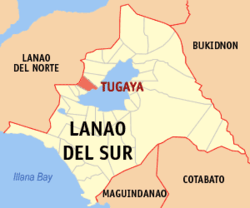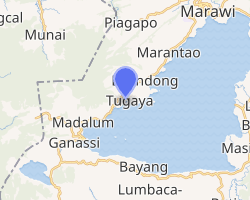Tugaya, Lanao del Sur
Tugaya, officially the Municipality of Tugaya (Maranao: Inged a Tugaya; Tagalog: Bayan ng Tugaya), is a 5th class municipality in the province of Lanao del Sur, Philippines. According to the 2015 census, it has a population of 23,814 people.[3]
Tugaya | |
|---|---|
| Municipality of Tugaya | |
 Map of Lanao del Sur with Tugaya highlighted | |
OpenStreetMap 
| |
.svg.png) Tugaya Location within the Philippines | |
| Coordinates: 7°53′02″N 124°10′19″E | |
| Country | |
| Region | Bangsamoro Autonomous Region in Muslim Mindanao (BARMM) |
| Province | Lanao del Sur |
| District | 2nd District |
| Barangays | 23 (see Barangays) |
| Government | |
| • Type | Sangguniang Bayan |
| • Mayor | Alfattah N. Pacalna |
| • Vice Mayor | Alber N. Balindong |
| • Congressman | Yasser A. Balindong |
| • Electorate | 12,756 voters (2019) |
| Area | |
| • Total | 155.10 km2 (59.88 sq mi) |
| Population (2015 census)[3] | |
| • Total | 23,814 |
| • Density | 150/km2 (400/sq mi) |
| • Households | 2,170 |
| Economy | |
| • Income class | 5th municipal income class |
| • Poverty incidence | 68.55% (2015)[4] |
| • Revenue (₱) | 72,117,445.01 (2016) |
| Time zone | UTC+8 (PST) |
| ZIP code | 9317 |
| PSGC | |
| IDD : area code | +63 (0)63 |
| Climate type | tropical climate |
| Native languages | Maranao Tagalog |
| Website | www |
The municipality, also known as Togaya, is known as the Industrial Capital of Lanao del Sur due to its Maranao crafts which includes gongs, drums, musical instruments, weaves, baskets, and metalwares, among others. It is also distinguished as a 'UNESCO Home for Culture and Heritage'.
Geography
Tugaya has a land area of 4028 hectares, equal to 40.28 square kilometers. Tugaya is located on the shores of the largest lake on Mindanao Island: Lake Lanao.
Barangays
Tugaya is politically subdivided into 23 barangays.
- Bagoaingud
- Bubong
- Buadi Alawang
- Buadi Dico
- Campong Talao
- Cayagan
- Dandanun
- Dilimbayan
- Gurain
- Engud Poblacion
- Lumbac
- Maidan
- Mapantao
- Pagalamatan
- Pandiaranao
- Pindolonan I
- Pindolonan II
- Putad
- Raya
- Sugod I
- Sugod A Mawatan
- Sumbaga Rogong
- Tangcal
Demographics
| Year | Pop. | ±% p.a. |
|---|---|---|
| 1918 | 2,182 | — |
| 1939 | 4,261 | +3.24% |
| 1948 | 7,039 | +5.74% |
| 1960 | 7,052 | +0.02% |
| 1970 | 12,262 | +5.68% |
| 1975 | 10,446 | −3.16% |
| 1980 | 12,406 | +3.50% |
| 1990 | 17,103 | +3.26% |
| 1995 | 17,552 | +0.49% |
| 2000 | 20,139 | +2.99% |
| 2007 | 24,017 | +2.46% |
| 2010 | 22,235 | −2.77% |
| 2015 | 23,814 | +1.31% |
| Source: Philippine Statistics Authority[3][5][6][7] | ||
Climate
| Climate data for Tugaya, Lanao del Sur | |||||||||||||
|---|---|---|---|---|---|---|---|---|---|---|---|---|---|
| Month | Jan | Feb | Mar | Apr | May | Jun | Jul | Aug | Sep | Oct | Nov | Dec | Year |
| Average high °C (°F) | 24 (75) |
24 (75) |
25 (77) |
26 (79) |
26 (79) |
25 (77) |
25 (77) |
25 (77) |
25 (77) |
25 (77) |
25 (77) |
25 (77) |
25 (77) |
| Average low °C (°F) | 20 (68) |
20 (68) |
20 (68) |
20 (68) |
21 (70) |
21 (70) |
20 (68) |
20 (68) |
20 (68) |
21 (70) |
20 (68) |
20 (68) |
20 (69) |
| Average precipitation mm (inches) | 159 (6.3) |
143 (5.6) |
166 (6.5) |
183 (7.2) |
357 (14.1) |
414 (16.3) |
333 (13.1) |
309 (12.2) |
289 (11.4) |
285 (11.2) |
253 (10.0) |
166 (6.5) |
3,057 (120.4) |
| Average rainy days | 18.4 | 17.2 | 20.6 | 23.4 | 29.3 | 29.2 | 29.9 | 29.4 | 27.7 | 28.7 | 25.5 | 19.9 | 299.2 |
| Source: Meteoblue [8] | |||||||||||||
Arts and culture
Tugaya is unique in that the town is inhabited almost entirely by craftsmen and artisans of various pursuits. Each household specializes in some form of art or craft that is part of traditional Maranao culture: back-strap loom weaving, tapestry weaving, and other kinds of handmade textile manufacture; foundry casting of various forms of brass or bronze vessels, instruments, and decorative items; wood-carving and mother-of-pearl inlay work; metalwork and silver- and gold-smithing—all of which utilize the traditional Maranao form of decoration, okir. From this community come the artisans called upon to decorate major forms of architecture in the traditional manner, e.g., the Maranao "torogan" or royal houses. Performance arts are also unique among the residents of Tugaya, where the penchant for the artistic spills out into everyday games and mundane articles of domestic use.
Textile weaving in Tugaya includes traditional Southeast Asian back-strap loom weaving, utilizing indigenous okir decorative motifs. Laborious, expert needle-weaving produces the complex "langkit" panels which are incorporated into the traditional Maranao garment, the "malong landap". Foundries employ the cire perdue or "lost wax" method to produce various types of bronze or brass products which follow traditional forms, such as the "gador" (a pair of ornate brass urns). Metal forging uses the traditional Southeast Asian double-bellows forge, and employs traditional tools. Other forms of metalwork include hand shaping and pounding of metal sheets, a laborious method which transforms flat metal sheets into sturdy, solid metal Maranao kulintang ensemble gong instruments, including "gandingan" and "agong". Woodworking includes manufacture of decorative objects, ornate furniture such as the traditional storage chest "baul", musical instruments such as the large drum "dadabuan", and ceremonial 12-foot-tall Maranao drums (such as were used for the adhan in the 1800s). Carved and painted wood products also feature the distinctive okir decorative motifs.
Nearly every member of the community is engaged in one or more of these forms of traditional arts and crafts, and many of their products are specially ordered on a regular basis by merchants in Davao City, which is the largest city on Mindanao island, a full day's drive from Tugaya. When displayed in the stores of Davao City, Tugaya's products are purchased by locals and international visitors, and by professional buyers from the department stores and tourist shops of MetroManila.
Thus, Tugaya supplies both inhabitants and visitors to Metro Manila with high quality, traditional, handmade items which are identified to customers as simply being "from Mindanao". Majority of items sold in Metro Manila as being "from Mindanao" are actually manufactured in Indonesia or Thailand, but are represented as being from Mindanao because the items were imported into Davao City by a middleman before being re-sold and transported to Metro Manila.
Torogan Architectural Planned Towns
The Kawayan Torogan is the oldest known torogan in the Philippines, located in Marantao municipality. It is a traditional Maranao house built for royal Maranao families. There was once a campaign where the people wanted the municipalities of Marantao and Tugaya to pass an ordinance where the architectural scheme of the two towns will follow only the totogan style, in effect, preserve the Maranao people's most royal architectural style and lead to the first two towns with a planned town landscape under an indigenous Maranao architecture. However, the campaign led to deaf ears due to little funding available.
Sunken Heritage
Aside from the current heritage of Tugaya today, the town also hosted the oldest mosque in Lanao del Sur until 1955 where the region was hit by an earthquake. The entire mosque sank beneath Lake Lanao along with hundreds of heritage pieces. Majority of the sunken artifacts have not been researched on by the National Museum of the Philippines due to tensions in the area. The lake is known as one of the deepest in the country and one of the 17 most ancient lakes in the world.
UNESCO Significance
The Old Town of Tugaya was formerly listed in the UNESCO Tentative List for Heritage Sites. However, it was dropped from the list as UNESCO officials announced that the site was better to be nominated in the UNESCO Intangible Cultural Heritage List instead due to its many intangible heritages. The National Commission for Culture and the Arts was tasked to do the job.
References
- "Municipality". Quezon City, Philippines: Department of the Interior and Local Government. Retrieved 31 May 2013.
- "Province: Lanao del Sur". PSGC Interactive. Quezon City, Philippines: Philippine Statistics Authority. Retrieved 12 November 2016.
- Census of Population (2015). "ARMM – Autonomous Region in Muslim Mindanao". Total Population by Province, City, Municipality and Barangay. PSA. Retrieved 20 June 2016.
- "PSA releases the 2015 Municipal and City Level Poverty Estimates". Quezon City, Philippines. Retrieved 12 October 2019.
- Census of Population and Housing (2010). "ARMM – Autonomous Region in Muslim Mindanao". Total Population by Province, City, Municipality and Barangay. NSO. Retrieved 29 June 2016.
- Censuses of Population (1903–2007). "ARMM – Autonomous Region in Muslim Mindanao". Table 1. Population Enumerated in Various Censuses by Province/Highly Urbanized City: 1903 to 2007. NSO.
- "Province of Lanao del Sur". Municipality Population Data. Local Water Utilities Administration Research Division. Retrieved 17 December 2016.
- "Tugaya, Lanao del Sur : Average Temperatures and Rainfall". Meteoblue. Retrieved 27 January 2019.